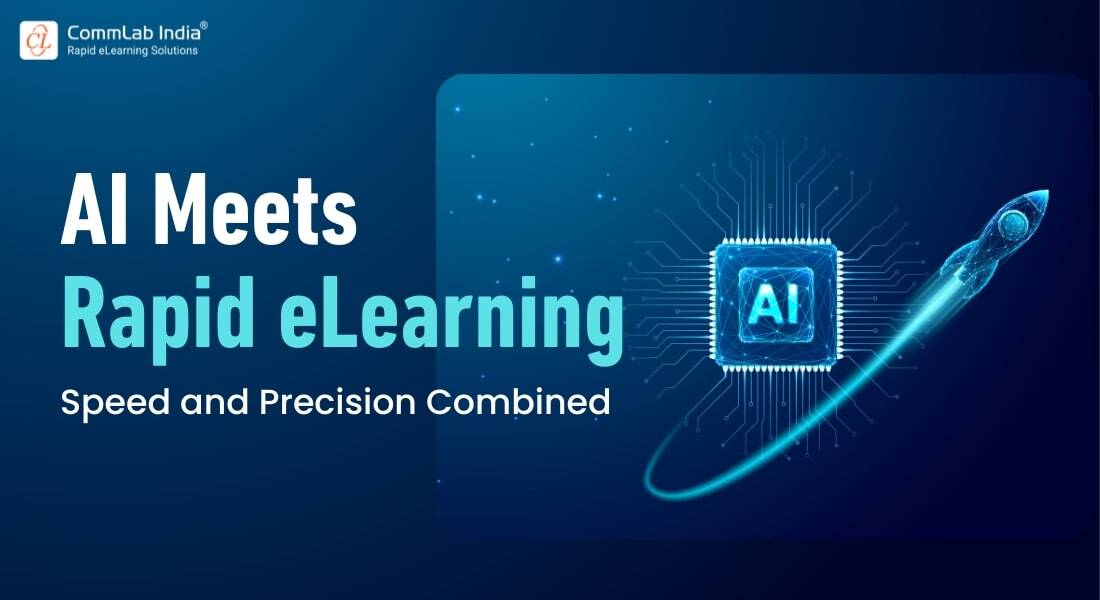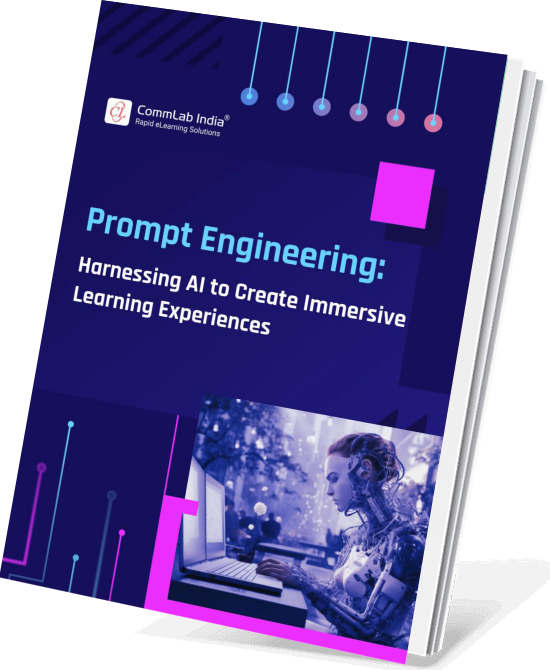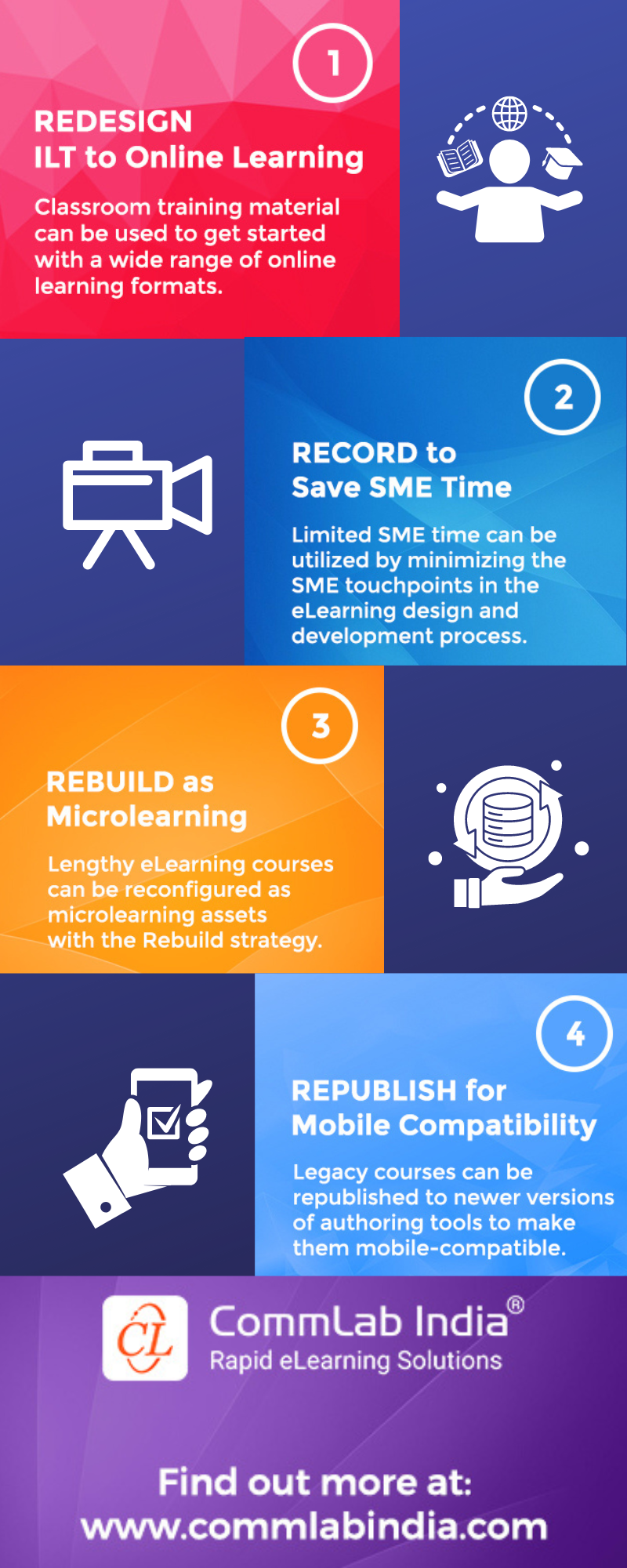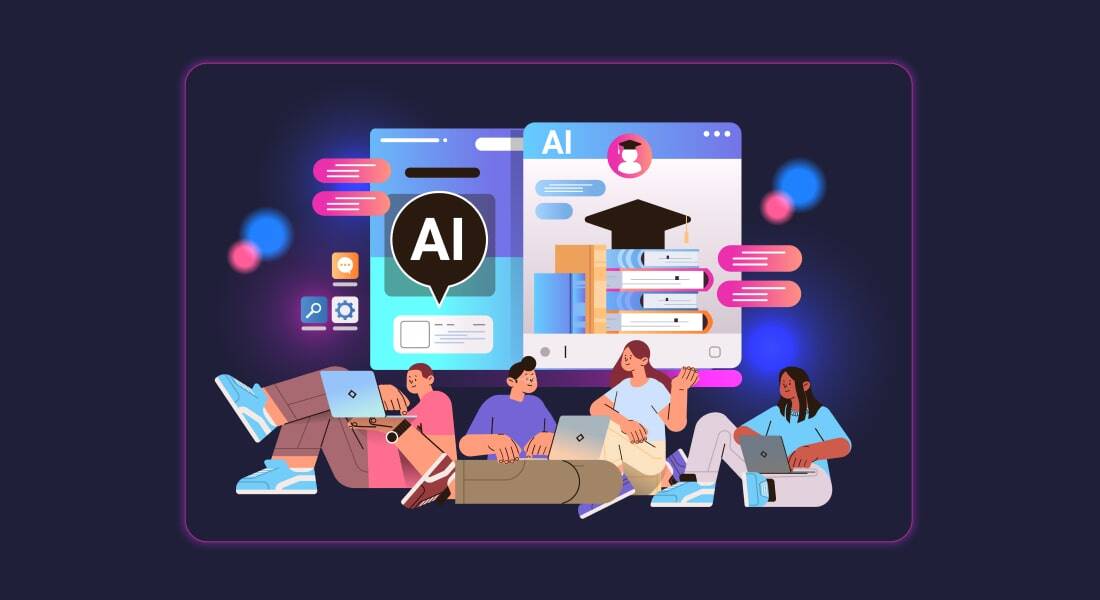AI-Powered Rapid eLearning Development: Faster, Smarter, Better

Today’s world of corporate training is highly demanding! It thrives on speed and innovation. Therefore, organizations must adapt quickly to stay ahead of the competition and be successful. This requires training programs that are agile, engaging, and impactful. That’s right! Effective training courses delivered on time not only enhance employee skills but also boost morale, productivity, and retention. However, the main challenge is how organizations can keep pace with the fast-changing business landscape. Because while business changes quickly, human beings need proper rest and relaxation to be their best creative self.
→ Download Now: Prompt Engineering for L&D Professionals!
Now imagine having a creative partner who never sleeps and effortlessly crafts customized content, engaging learning experiences, and interactive modules in record time. Sounds like a dream, right? Well, the future of rapid eLearning development is here! Generative AI (GenAI) is turning the dream into reality.
Table Of Content
- What is Rapid eLearning?
- What are the 4 Rs of Rapid eLearning?
- What are the Benefits of Using GenAI Tools in Rapid eLearning?
- What are the Top GenAI Tools for Rapid eLearning Development?
What is Rapid eLearning?
Rapid eLearning is an approach used to design and deliver eLearning courses quickly while maintaining quality standards. It is especially useful when time is limited, as it focuses solely on essential content and eliminates unnecessary extras. This approach uses rapid eLearning authoring tools and prebuilt templates to streamline the instructional design process, saving significant time. By emphasizing performance-based learning objectives, rapid eLearning aligns with business goals and helps boost training ROI.
What are the 4 Rs of Rapid eLearning?
Rapid eLearning development is faster and more cost-effective than traditional eLearning as it leverages pre-existing content and utilizes rapid authoring tools equipped with built-in asset libraries and templates.
The key to its success lies in the 4 Rs strategy, which provides solutions to meet diverse training needs.
Whether you need to roll out quick eLearning courses to train a large workforce, repurpose existing content into fresh formats, reuse valuable resources to save time and costs, or refresh outdated training with up-to-date material, the 4Rs of rapid eLearning have you covered.
What are the Benefits of Using GenAI Tools in Rapid eLearning?
A Gartner survey indicates a substantial acceleration in the adoption of AI-powered applications.
Using GenAI tools in rapid eLearning can prove beneficial in various ways. Let’s take a look.
1. Personalized and Adaptive Learning
One of the most important benefits of using GenAI tools in rapid eLearning is their ability to create AI-powered personalized learning experiences without taking up too much time and effort. You read it right! AI tools can easily analyse learners' behaviours, preferences, and performance data. Based on this data, training managers can tailor the training content to meet individual needs. This ensures that each learner receives the most relevant and effective training materials and leads to improved learner engagement, comprehension, and retention.
Moreover, AI tools also support adaptive learning as they can adjust the difficulty level of exercises, provide targeted feedback, and suggest additional resources based on a learner's progress.

2. Rapid Content Creation

Prompt Engineering — Harnessing AI to Create Immersive Learning Experiences
Learn the Art of Crafting Effective Prompts and Get Desired Outcomes
- What is Prompt Engineering?
- Why is Prompt Engineering Important?
- How to Craft Effective Prompts?
- And More!
The need for speed is no longer limited to movie names and game series. It has become a common phenomenon in the business world as well. While every business tries its best to match the pace of changing business scenarios and stay ahead of the competition by delivering on-time training, it’s not always that easy. To help businesses make the most of their time and resources, GenAI comes in as a blessing.
GenAI tools significantly speed up the content creation process. They do so by automating repetitive tasks that typically require considerable time and effort. AI tools also come in handy for instructional designers while working on various tasks like:
- Drafting learning objectives
- Creating course content
- Developing relevant multimedia elements
- Curating impactful eLearning assessments
This results in efficient, rapid eLearning development cycles and the ability to quickly update and expand course offerings.
3. Enhanced Learner Engagement
Do you want to maximize training ROI? Well, learner engagement is an aspect you cannot ignore. It is the heart and soul of a successful rapid eLearning program. However, making your training courses engaging is not as easy as it might sound. The reasons might vary from irrelevant interactivities to unnecessary information to blocks of text. To avoid such pitfalls and ensure balanced, engaging eLearning courses, you can leverage GenAI tools.
You can use AI tools to create interactive and relevant training content. Courses tailored to learners' interests and learning styles make learning more enjoyable and effective. Apart from this, you can mix and match different multimedia components and eLearning interactivities to create participation opportunities for learners. It will help transform the learning process from passive to active.

These interactive elements keep learners involved and motivated, leading to better learning outcomes.
4. Increased Accessibility
When all the employees are delivering their best and are in sync with the company’s business objectives and goals, the chances of the organization succeeding increase significantly. But what if some of the employees are unable to do so just because they couldn’t access the corporate training when they needed it the most? To avoid such heartbreaking, disappointing situations, you need to ensure that your training courses are accessible to all your employees.
In this venture of yours, GenAI tools can prove beneficial as they can help make rapid eLearning courses more inclusive and accessible. Wondering how? Well, with the help of AI tools, you can generate training content in various formats in a short amount of time. Moreover, you can easily translate the training material into multiple languages using an AI tool. It fosters better understanding and application of concepts.
What are the Top GenAI Tools for Rapid eLearning Development?
Top GenAI Tools for Rapid eLearning Development
From creating engaging content to designing visuals, these tools make course development faster and smarter.
1. ChatGPT
2. Midjourney
3. Vyond Go
1. ChatGPT by OpenAI
ChatGPT is a language model developed by OpenAI. It is designed to generate human-like text based on the input it receives. It's capable of understanding and generating coherent and contextually relevant responses. This aspect makes it suitable for various applications such as customer support, content creation, and conversational agents. Now let’s take a look at some of the notable features.
Notable Features of ChatGPT:
- Natural Language Processing (NLP): ChatGPT can understand and generate text in a conversational style, making interactions feel natural and intuitive.
- Customizable Responses: The model can be fine-tuned to adopt specific tones, styles, and content preferences. This can help instructional designers align the training content with the brand voice.
- Scalability: ChatGPT can handle large volumes of queries simultaneously, making it suitable for widespread deployment in corporate training settings.
- Integration with Applications: It can be integrated into various platforms and applications. This feature allows for seamless use of chatbots, learning management systems (LMS), or other digital tools that increase the efficiency of the training program.
Use Cases of ChatGPT in Rapid eLearning Development
ChatGPT enhances rapid eLearning by serving multiple roles in the development process. It can be used as an interactive chatbot and virtual tutor. In this role, it can provide learners with instant feedback, answer their questions/queries, and guide them through the course material.
Instructional designers can use ChatGPT for the content generation process. With the help of this AI tool, they can quickly draft learning objectives and create text-based materials like quizzes, FAQs, course outlines, etc.
Moreover, you can use ChatGPT to analyze learners' inputs. Based on the analysis, you can offer personalized recommendations and adapt content to suit individual learning needs, making the learning experience more tailored and effective.
2. Midjourney
Midjourney is an AI-powered image generation tool that leverages advanced machine-learning techniques to create stunning and realistic images based on textual descriptions. By inputting prompts, eLearning developers can generate images that match their creative vision. This tool is widely used for digital art, concept design, and other visual content creation needs.
Notable Features of Midjourney:
- Text-to-Image Generation: Midjourney takes text descriptions and converts them into visually appealing images. It enables eLearning developers to bring their ideas to life without needing advanced graphic design skills.
- High-Quality Visuals: It produces high-resolution images that are both detailed and aesthetically pleasing. This feature makes the images suitable for professional use.
- Creative Customization: eLearning developers can easily refine and adjust the image output to better suit their needs. The flexibility offered by Midjourney in terms of style, color, and other visual aspects definitely comes in handy to create relevant, engaging pictures for the training course.
- User-friendly Interface: This AI platform is designed in an intuitive manner. Therefore, it is accessible for users with varying levels of technical expertise.
Use Cases of Midjourney in Rapid eLearning Development
Midjourney plays a significant role in rapid eLearning development by enhancing visual content creation. eLearning developers can generate custom visuals for rapid eLearning courses, making the training content more engaging and visually stimulating. This capability is particularly useful for creating unique illustrations, infographics, and conceptual images that align with specific learning objectives.
Additionally, Midjourney supports scenario-based learning by creating realistic images that help develop training modules where learners can visualize situations they might encounter. This whole process makes the learning experience more enriching and immersive. Instructional designers can also use Midjourney for quick prototyping of visual elements, enabling faster feedback loops and adjustments. And finally, Midjourney allows for the creation of culturally and contextually relevant visuals. This aspect is a lifesaver for eLearning developers as it comes in handy while working on global eLearning initiatives that require localization.
3. Vyond Go
Vyond Go is an AI-driven animation tool that enables users to create professional-quality animated videos in no time at all! It's perfect for individuals and businesses that want to produce engaging video content without needing to be video production experts. This characteristic trait makes it a must-try for rapid eLearning development.
Notable Features of Vyond Go:
- Pre-built Templates: Vyond Go offers a wide range of customizable templates for different industries and purposes, making video creation faster and more straightforward.
- AI-Powered Automation: The tool includes AI-driven features that streamline the video creation process. This includes scene suggestions, automatic animation, character generation, etc.
- Character Customization: eLearning developers can create custom animated characters to reflect the learners’ demographics. It sets the foundation of inclusivity with culturally relevant and personalized content.
- Text-to-Speech: Vyond Go includes text-to-speech functionality in multiple languages. This allows for easy narration without needing professional voiceovers.
- Drag-and-Drop Interface: Its user-friendly interface allows for easy editing, making it easy to use for people with little or no prior experience in creating animated videos.
Use Cases of Vyond Go in Rapid eLearning Development
Vyond Go is an effective tool for creating engaging, relevant animated training videos for rapid eLearning courses. eLearning developers can use it to develop explainer videos, animated case studies, simulations, and more. It's great for facilitating scenario-based learning too! eLearning developers can use it to bring real-life workplace scenarios to life and make even the trickiest concepts easier to understand through visual storytelling.
Vyond Go is also great for making microlearning videos. These short, focused modules really help learners engage with and remember the content. The text-to-speech feature makes the eLearning translation and localization process more efficient and easier. Therefore, eLearning developers can create multilingual eLearning materials for different learner groups quickly. Even better, learning architects can integrate the interactive visual content they create with Vyond Go into eLearning platforms.
Ready to create stunning corporate training videos without the hassle? Let’s dive into mastering Vyond Go!
4. Synthesia
Synthesia is an AI-driven video generation platform that allows users to create videos with natural-sounding, human-like AI presenters. It leverages AI to produce engaging video content without the need for cameras, actors, or production crews.
Notable Features of Synthesia:
- AI Avatars: Users can select from a variety of AI avatars who will deliver the content, making it easy to create videos in a professional format.
- Multilingual Support: It supports multiple languages and accents. This allows eLearning developers to create videos in different languages to cater to global learners.
- Script-Based Video Creation: It relies on the text-to-video method. It generates videos based on the scripts added as input. This reduces the time and cost involved in video production for corporate training.
- Custom Avatars: eLearning developers can create custom avatars that match their brand identity.
Use Cases of Synthesia in Rapid eLearning Development
Synthesia is an amazing tool that makes the rapid eLearning development process better in so many ways! Firstly, it's so easy to use. eLearning developers can quickly produce video lectures and tutorials using Synthesia. This allows organizations to scale content delivery without relying on extensive video production resources.
Even better, Synthesia supports the creation of multilingual training videos. It ensures consistent training across different regions, making it easier for organizations to provide effective training regardless of location. And it's ideal for creating engaging onboarding videos that introduce new employees to company policies, culture, and procedures, streamlining the onboarding process.
Check out the video below to learn the effective tips that will help you take your Synthesia videos to the next level.
Wrapping Up!
Organizations using GenAI tools for rapid eLearning gain a competitive edge in employee training. GenAI enables the creation of engaging, interactive, learner-focused experiences with minimal time and effort. By integrating GenAI into eLearning development, companies can speed up eLearning course creation, boost learner engagement, and improve retention.
At the heart of effective human-AI interaction lies the art of creating relevant prompts. But if only curating proper, useful prompts were that easy. But don’t worry! CommLab India's eBook on prompt engineering will guide you on how to create useful prompts for receiving desired outcomes from the GenAI tools. Check it out now!










